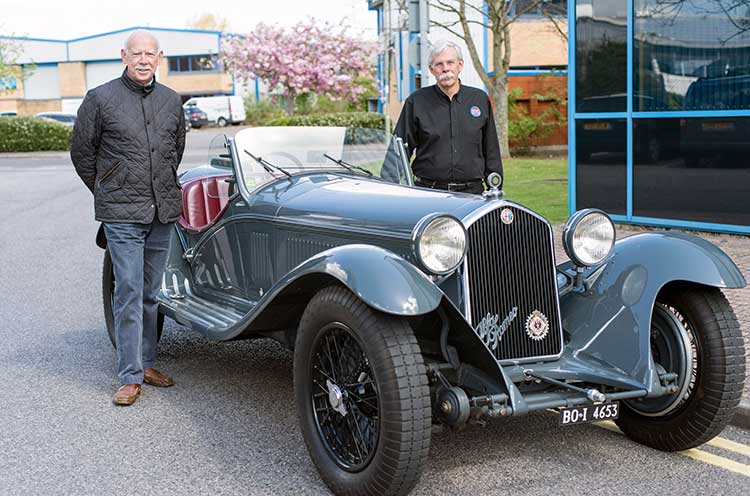From its origins more than 30 years ago as a backyard business, Jim Stokes Workshops Ltd (JSW Group) has grown steadily over the years, and now easily fills five spacious units on an industrial estate in Waterlooville, Hampshire, UK. The company employs a team of 50, many of whom are specialist technicians in one of the most rarefied sectors of automotive engineering.
When he started the business, Jim was probably regarded as a little bit of an eccentric. This was in the years before classic cars had become collectibles for billionaires, and “safe” repositories for global capital, much like Old Masters have become, since.
Jim’s almost singular obsession at the time was the Alfa Romeo 8C, which the Milan-based company built from 1931 to 1939. The straight-eight engine and its chassis were configured in various guises for road and track over the years, by the likes of Enzo Ferrari’s fledgling scuderia, as well as the works Alfa team. They were driven by some of the most famous names in motor racing – including Tazio Nuvolari, at some of the best-known races, such as Le Mans.
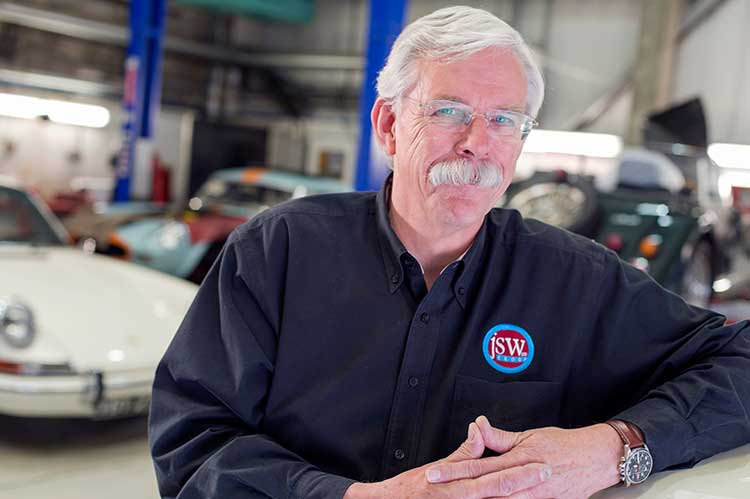
What no one really knew when young Jim first began his fettling and restoration activities, was that the 8C’s scarcity and illustrious history would eventually make it one of the most sought after vintage cars in the world (auction houses love them for the 7- and 8-figure prices they command).
In the intervening years, JSW Group has built a reputation around the world for 8C expertise, as well as in-depth knowledge for similarly rare and exotic Aston Martins, Ferraris, Jaguars, Lancias, Mercedes, and Rolls-Royces, which pass through for repairs, pre- and post-race TLC and, occasionally, full restorations.
Famously, the company has also built six, painstaking recreations of Lancia D50s, and a diminutive yellow Ferrari 156 Sharknose: classic monoposto F1 cars from the 1950s and 60s, respectively. The detail and authenticity of the cars is such that they qualify for FIA passports, allowing them to compete in strictly controlled events reserved for thoroughbred classics.
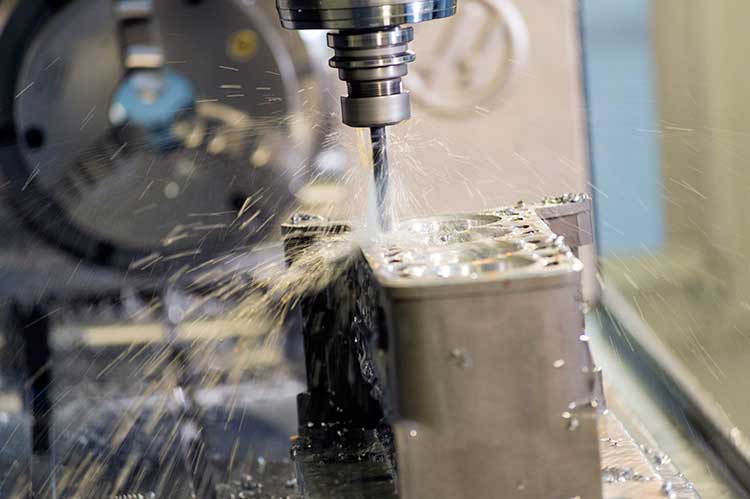
Today, the JSW Group has four divisions: Triple M focuses on part manufacturing operations; South Shore specialises in bodywork and fabrication; Classics by JSW is more “everyday” vehicles; and Jim Stokes Workshops Ltd, which is the group’s best known business.
Triple M owns three Haas CNC vertical machining centres: a VF-2, a VF-5, and a VF-6.
The “V8s”, as Jim calls them, allow Triple M to produce one-offs or batches of better-than-new components, such as cylinder heads, cylinder blocks, valves, crankcases, carburettors, oil and water pumps, and plenty more besides.
“I like the American engineering, and I like the way Haas machines work,” he says “They’ve proven themselves as hard working, reliable machines, and they’ve allowed us to bring so much more of our part manufacturing back in-house.”
The story of how the company opted for Haas machines is interesting. Tony Fairbairn, one of the JSW Group’s long-serving machinists, had left the firm to pursue an opportunity at another local company – in a completely different industry sector, where he was running several Haas machines. JSW missed him, so a plan was hatched to lure him back.
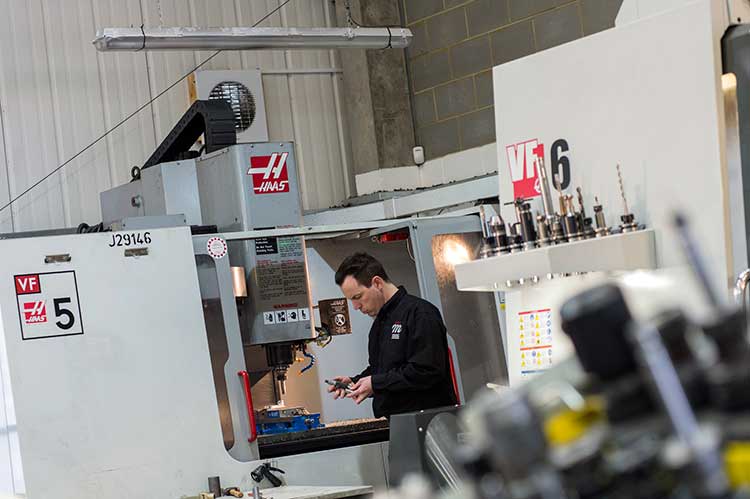
“I knew I needed to upgrade the machines we had,” Jim recalls, “and I knew if I invested in Haas, Tony would consider coming back. I already knew a lot of people using Haas machines, so I had no reservations about buying them.” He had a long-term plan to do as much machining as possible within the business. “In the early days, my philosophy was to do everything myself,” he says. “But after five years of working 18 hours a day, seven days a week, I realised I couldn’t do it. However, you give it to subcontractors and quickly realise that they don’t do what you want.”
Recreated engines
On any particular weekday, The JSW Group garage may contain several Alfa 8Cs, usually owned by media-shy big name collectors or well-known, very successful business people. A frequent visitor to the shop is the 1932 Le Mans 24-hour race winner.
“The owner of that car, like many others, would not race it with the original engine; it’s too valuable from a historic point of view. Instead, we manufacture a replacement engine to his specification. We can do that with engines, gearboxes, and axles, whatever. So if you want to race these things hard, you can do it without damaging the original vehicle. All of the component machining is done on the Haas machines.”
Of the three Haas CNC machine tools on site, the VF-5 has a 10,000-rpm spindle, while the VF-2 and the VF-6 have a 7500-rpm spindle. Two of the machines have a fourth-axis Haas rotary table.
“We currently have most of the machine performance and capacity we need. We have to machine very large crankcases for AC engines, and so we need something with 1.6 m of travel, which means the VF-6 is perfect. It has plenty of tools [24 + 1], and we also have a fourth-axis on it, which we use when we run the machine overnight for making parts like stub axles. During the day, we use the rest of the bed for other jobs. For instance, at the moment we’re running cylinder blocks, which we make in two identical halves. We can produce 95 percent of our engine parts using four axes, as the port work is not particularly sophisticated.”
A very small part of the JSW Group business produces parts for film companies. For example, the company recently recreated the rear section of the Ford Mustang used in Fast & Furious 6, a film that took $788 million at the box office. “We were asked to make the tail in aluminium,” says Jim, “because the film company wanted it to crush on impact like a beer can. We ended up making five versions.
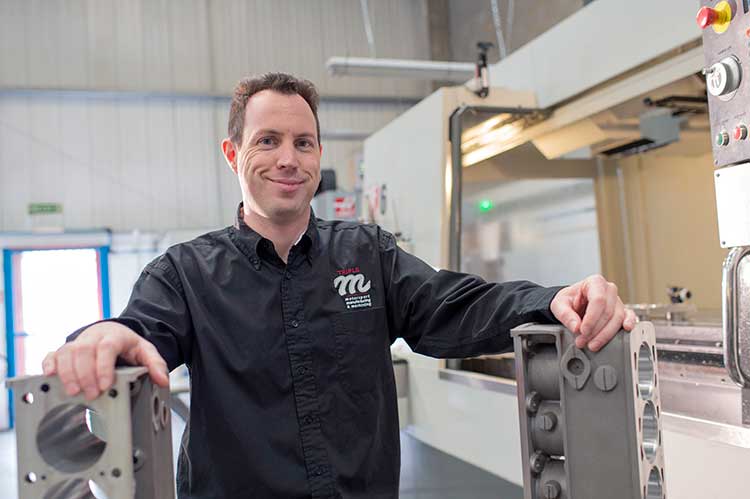
“We also get a lot of commissions and projects from high net worth individuals around the world. It’s not unusual for customers to ask if there’s anywhere nearby to land a helicopter. Sometimes we need to go to the car if the car cannot come to us; we’re happy to send employees all over the world if necessary.”
The Haas machines also produce parts for the group’s Classics by JSW division. This is where the company restores, repairs, and rebuilds more “affordable” classic cars, including Porsche 911s, MGs, and even humble Morris Minors. The Haas machines are used to make components that are simply no longer available.
Jim Stokes is unequivocal and outspoken about the usefulness and versatility of Haas machine tools. “I can take a job, put it on any of the Haas machines, and get the same result in terms of quality and repeatability,” he enthuses. “The CNC of each machine is exactly the same as the others. The added advantage is, if you can use one Haas, you can use them all.”
Tony Fairbairn’s insistence JSW invest in Haas machines was well founded. “He came back to the company and is now machine shop manager,” says Jim. “In the fullness of time, we intend to upgrade every machine in our workshop to Haas, including, perhaps, some 5-axis machines. Ultimately, the potential in our business is definitely in the machine shop. We have several projects lined up, and if they all come to fruition, the next two or three years could be mind blowing!”
This story also has a video to accompany it. You can find it here

